Texas Roadhouse earnings missed by $0.05, revenue topped estimates
Introduction & Market Context
Pinnacle West Capital Corporation (NYSE:PNW), the parent company of Arizona Public Service (APS), presented its first-quarter 2025 financial results on May 1, revealing a year-over-year decline in quarterly earnings while maintaining a positive long-term outlook. The company’s stock closed at $95.18 on April 30, near its 52-week high of $96.50, reflecting investor confidence despite the quarterly performance dip.
The presentation follows Pinnacle West’s better-than-expected Q4 2024 performance, where the company reported a smaller-than-anticipated loss of $0.06 per share and revenue of $1.1 billion, exceeding forecasts. This context provides important perspective for evaluating the company’s Q1 2025 results and forward-looking guidance.
Quarterly Performance Highlights
Pinnacle West reported first-quarter 2025 earnings per share (EPS) of $0.04, down from $0.15 in the same period of 2024. The company’s presentation provided a detailed breakdown of the factors influencing this decline.
As shown in the following waterfall chart comparing Q1 2025 to Q1 2024 results, several factors contributed to the year-over-year decrease:
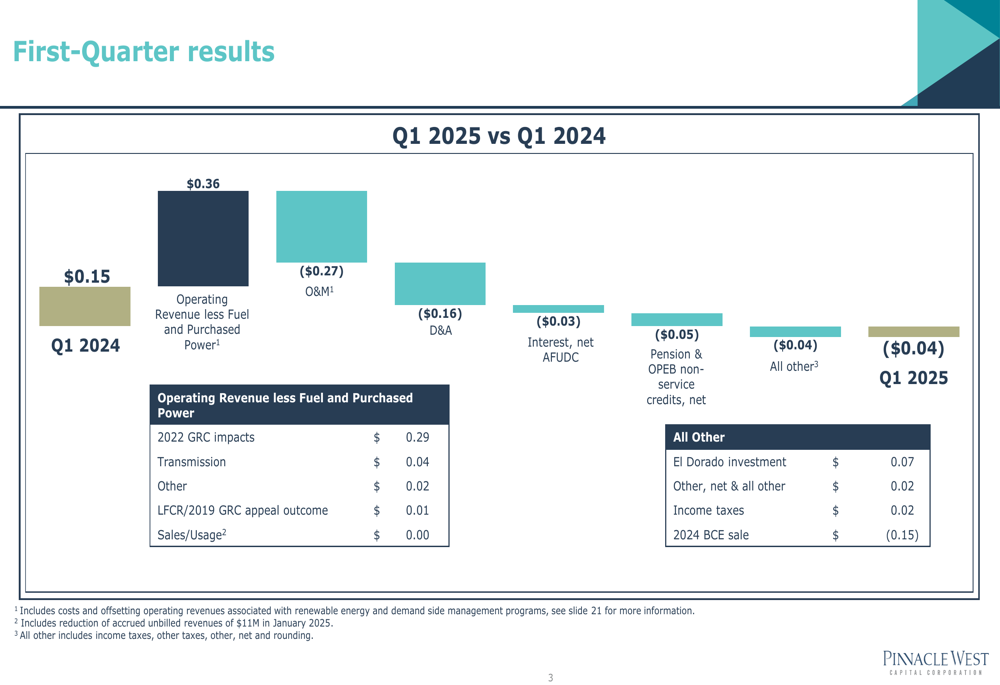
The primary negative impacts included increased operations and maintenance expenses (-$0.27), higher depreciation and amortization (-$0.16), and increased interest expenses net of AFUDC (-$0.03). These were partially offset by positive contributions from operating revenue less fuel and purchased power costs (+$0.36), which was driven primarily by the 2022 General Rate Case impacts (+$0.29) and transmission revenue (+$0.04).
Forward-Looking Guidance
Despite the quarterly earnings decline, Pinnacle West maintained its 2025 EPS guidance of $4.40-$4.60 and reaffirmed its long-term EPS growth target of 5-7% from the original 2024 midpoint. This guidance is supported by several key assumptions and drivers:
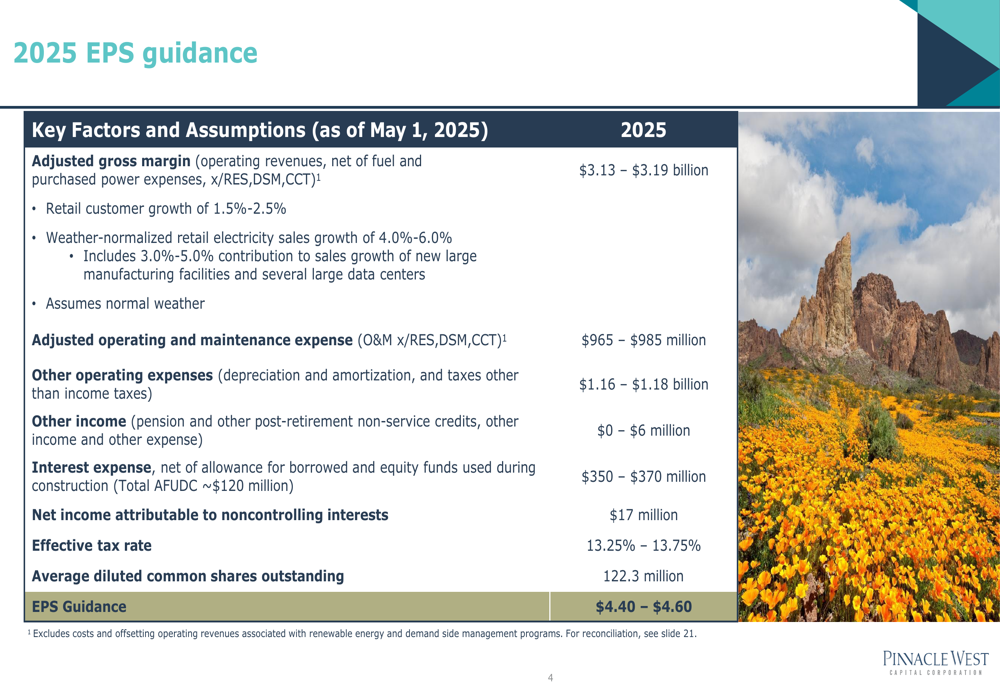
The company’s 2025 guidance is built on projected adjusted gross margin of $3.13-$3.19 billion, adjusted O&M expenses of $965-$985 million, and other detailed financial assumptions. Management expects retail customer growth of 1.5%-2.5% and weather-normalized retail electricity sales growth of 4.0%-6.0%, including 3%-5% from large commercial and industrial customers.
The following slide further details the key drivers influencing the 2025 outlook:
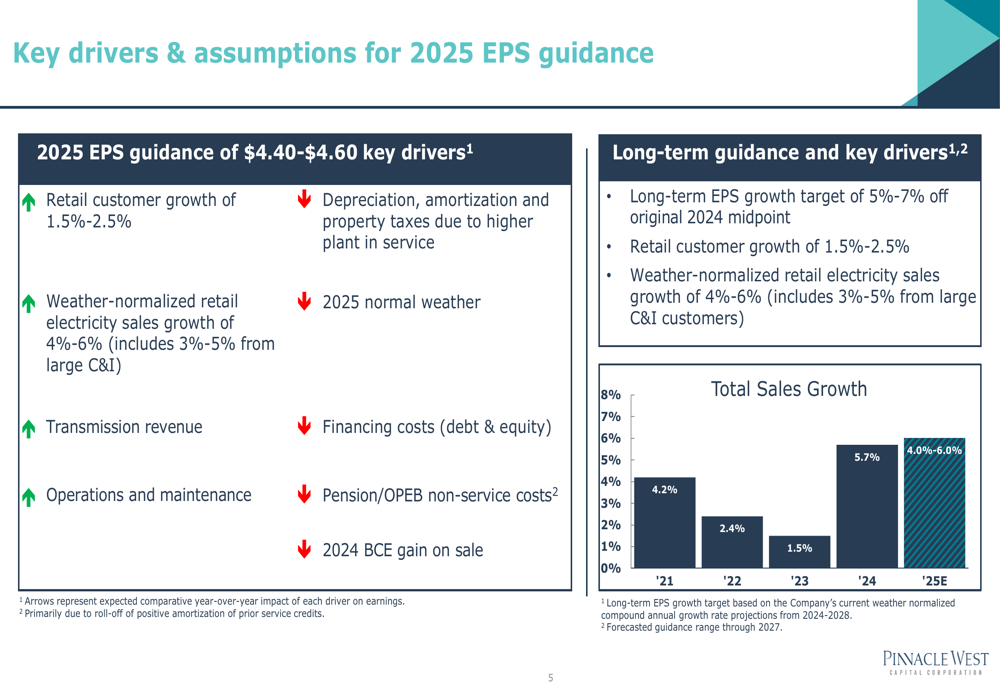
Notably, the company’s total sales growth has shown variability in recent years, with 4.2% growth in 2021, 2.4% in 2022, 1.5% in 2023, and 5.7% in 2024. The 2025 projection of 4.0%-6.0% suggests continued momentum, aligning with the robust 5.7% growth achieved in 2024.
Capital Investment and Growth Strategy
A cornerstone of Pinnacle West’s strategy is its ambitious capital expenditure plan totaling $9.66 billion for 2024-2027, representing a 24% increase from the plan outlined in Q4 2023. This investment is designed to support system reliability and accommodate Arizona’s continued growth.
The following chart details the capital expenditure breakdown by year and category:
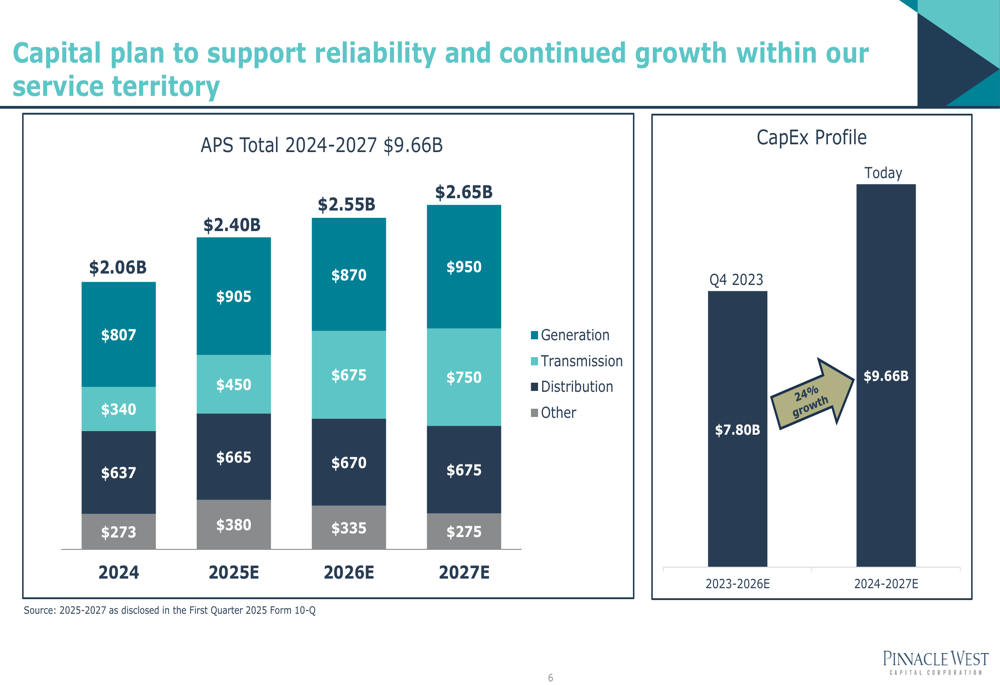
The capital plan shows a steady increase in annual investment from $2.06 billion in 2024 to $2.65 billion in 2027, with significant allocations to generation, transmission, and distribution infrastructure. This investment is expected to drive rate base growth from $11.2 billion in 2023 to $14.2 billion by 2027, representing a compound annual growth rate of 6-8%.
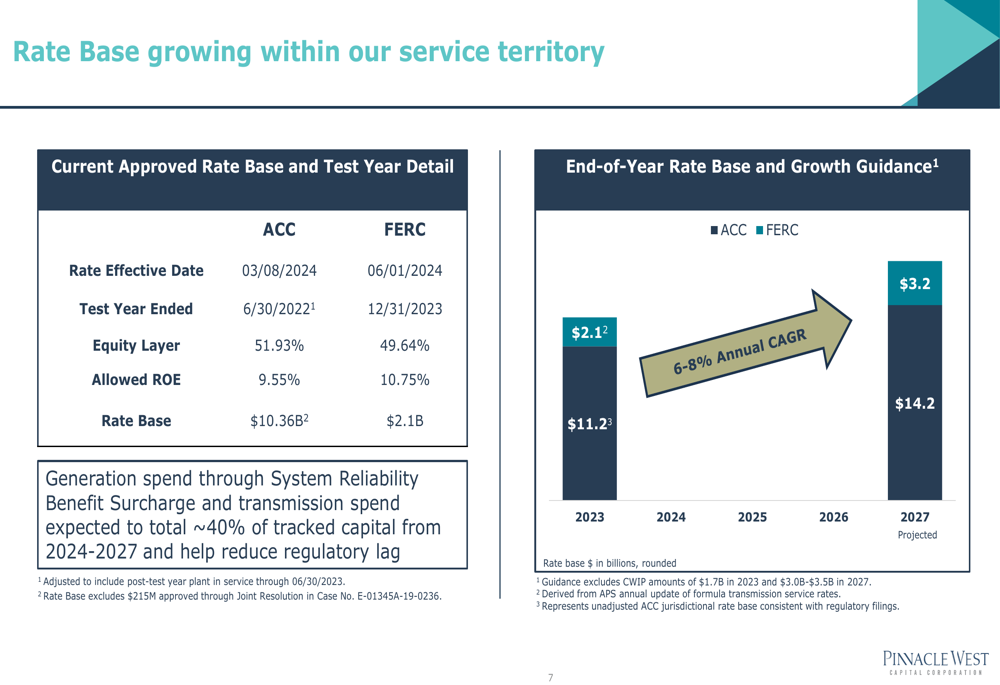
The company’s rate base is divided between ACC (NSE:ACC) (Arizona Corporation Commission) jurisdiction at $10.36 billion and FERC jurisdiction at $2.1 billion, with allowed returns on equity of 9.55% and 10.75%, respectively. This regulatory framework provides visibility for investors regarding the company’s ability to earn returns on its capital investments.
Arizona Market Dynamics
Pinnacle West’s growth strategy is underpinned by Arizona’s attractive market dynamics, which include strong population growth and economic development across multiple sectors.
As illustrated in the following map, Arizona’s economic development spans diverse industry clusters:
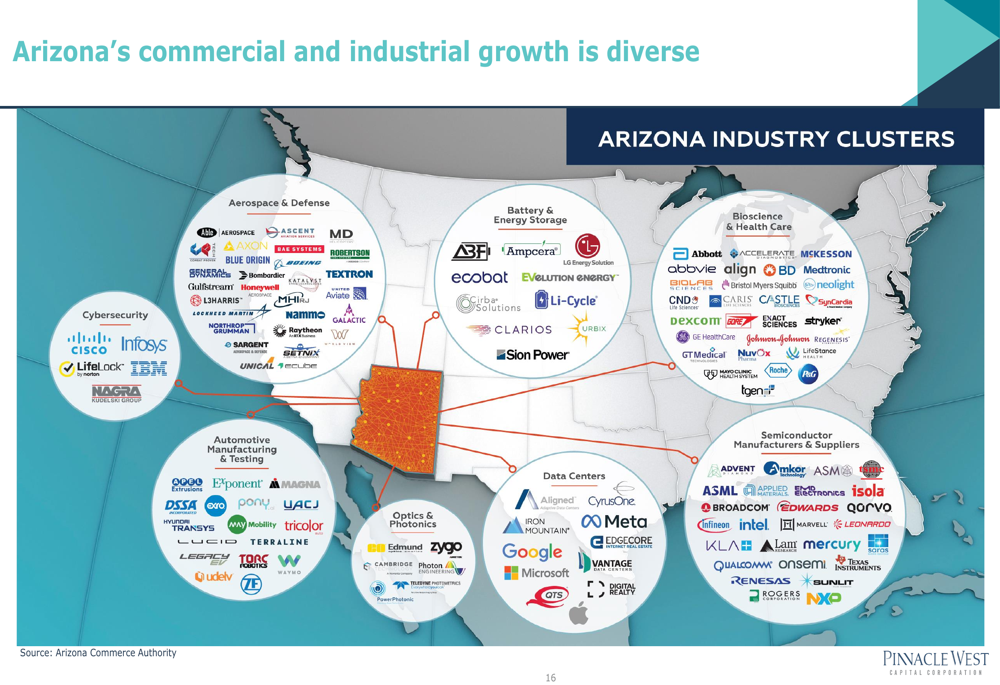
The state’s economic diversity includes aerospace and defense, battery and energy storage, bioscience and healthcare, cybersecurity, automotive manufacturing and testing, optics and photonics, data centers, and semiconductor manufacturing. This diversification provides resilience to Pinnacle West’s customer base and supports the company’s growth projections.
Phoenix’s housing affordability compared to other major cities in the region, Maricopa County’s ranking as the third-fastest growing U.S. county, and Phoenix’s position as the top growth market for manufacturing all contribute to the company’s positive outlook for continued customer growth.
Financial Position and Financing Strategy
To support its capital investment plan, Pinnacle West has developed a balanced financing strategy for 2025-2027. The company plans to fund approximately $7.6 billion in capital investment through a combination of $3.6 billion in cash from operations, $2.5-$2.7 billion in APS debt, $500-$700 million in PNW debt, and $700-$900 million in PNW equity.
The company maintains solid investment-grade credit ratings from all major rating agencies, with stable outlooks from Moody’s, S&P, and Fitch. Management has established balance sheet targets including an APS equity layer above 50% and a PNW funds from operations to debt ratio of 14-16%.
Risk Management and Operational Focus
Given the increasing importance of wildfire risk management in the utility sector, Pinnacle West highlighted its comprehensive approach to wildfire mitigation:
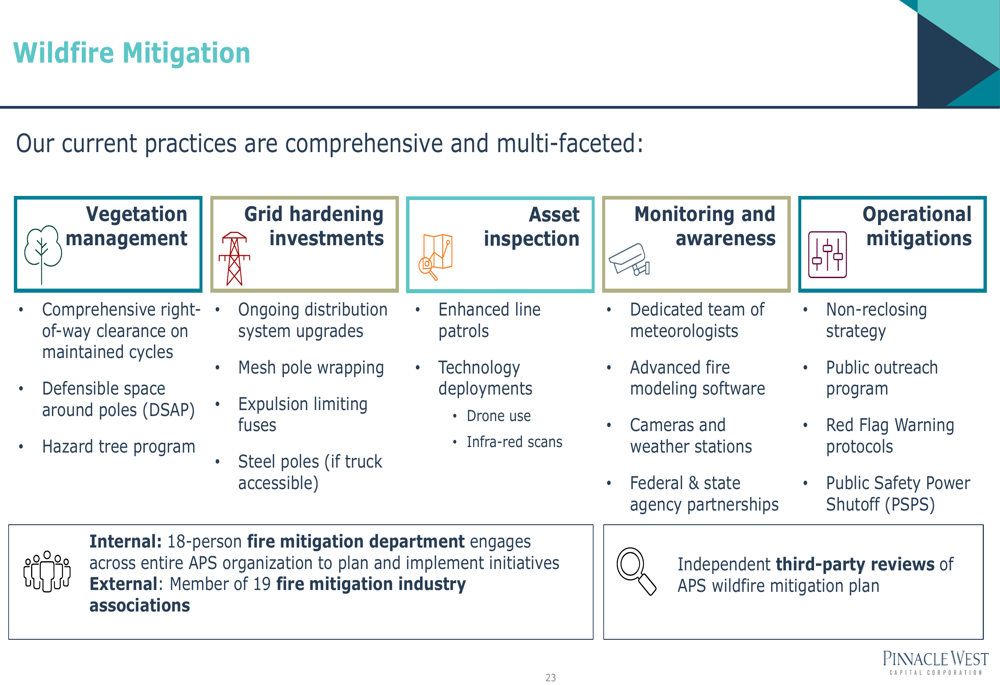
The company’s wildfire mitigation practices span five key areas: vegetation management, grid hardening investments, asset inspection, monitoring and awareness, and operational mitigations. These efforts are coordinated by an 18-person fire mitigation department that engages across the entire APS organization and participates in 19 fire mitigation industry associations.
This comprehensive approach to risk management is particularly important given the potential legislative changes related to wildfire mitigation mentioned in the company’s Q4 2024 earnings call, which could impact operational costs.
Operational Efficiency and Cost Management
Pinnacle West is focusing on operational efficiency to help offset cost pressures. The company’s operations and maintenance (O&M) guidance for 2025 shows a reduction in core O&M excluding planned outages compared to 2024, reflecting a lean culture driving a declining O&M per MWh goal.
The company also highlighted its System Reliability Benefit Surcharge (SRB), which will expand its capacity to self-build generation with reduced regulatory lag. SRB projects, which compete on cost and reliability through an All-Source Request for Proposals process, include the 150 MW Agave BESS (Phase I), 90 MW Sundance Expansion, 168 MW Ironwood Solar, and 397 MW Redhawk Expansion, with in-service dates ranging from 2026 to 2028.
Additionally, Pinnacle West is pursuing transmission expansion to increase resiliency and support customer growth, with projects including Sundance to Milligan (22 miles, 230 kV), Ocotillo to Pinnacle Peak (25 miles, 230 kV), Panda to Freedom (40 miles, 230 kV), and Jojoba to Rudd (25 miles, 500 kV), scheduled for completion between 2027 and 2030.
While Pinnacle West’s Q1 2025 earnings showed a year-over-year decline, the company’s robust capital investment plan, strong Arizona market fundamentals, and balanced financing strategy position it well for long-term growth. Investors will be watching closely to see if the company can execute on its ambitious plans while navigating the challenges of regulatory changes and economic fluctuations in its service territory.
Full presentation:
This article was generated with the support of AI and reviewed by an editor. For more information see our T&C.
